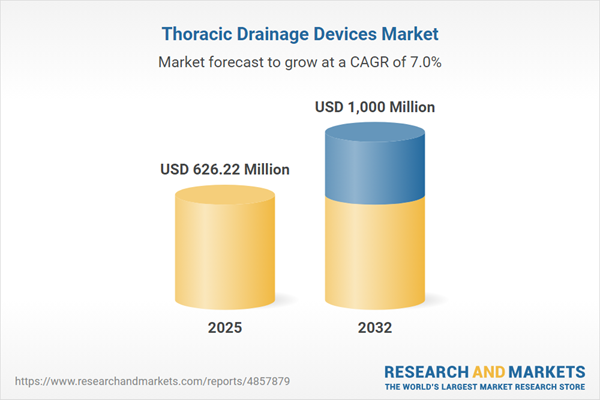Speak directly to the analyst to clarify any post sales queries you may have.
The thoracic drainage devices market is evolving rapidly as clinical organizations drive digital transformation for greater efficiency and improved outcomes. These solutions are central to streamlining workflows, bolstering oversight, and supporting future-ready innovations in modern healthcare environments.
Market Snapshot: Thoracic Drainage Devices Market Size and Trends
The global thoracic drainage devices market is projected to expand at a robust pace, with forecasted revenues climbing from USD 585.24 million in 2024 to USD 626.22 million in 2025. With a 6.98% compound annual growth rate, market momentum is driven by increasing demand for minimally invasive respiratory treatments and widespread integration of digital technology. Healthcare organizations are adopting advanced thoracic drainage systems to support clinical workflow integration and enable real-time patient tracking. Improvements in system connectivity and progressive procurement strategies are lowering adoption barriers, facilitating modernization, and enhancing clinical efficiency across diverse care settings.
Scope & Segmentation of the Thoracic Drainage Devices Market
- Product Type: Digital drainage systems allow for direct clinical monitoring and faster decision-making. Portable suction devices, available in both disposable and reusable formats, are adaptable to hospitals, outpatient centers, and home care environments. Water seal systems in both wet and dry designs meet various requirements for routine and advanced thoracic procedures.
- End User: Hospitals are leading in the adoption of advanced drainage solutions, especially when managing acute and perioperative cases. Ambulatory surgery centers and home care providers are utilizing portable units to enable care outside traditional clinical settings.
- Application: These devices are essential in treating pleural effusion, pneumothorax, and managing post-surgical fluid. Their benefits extend through critical care, surgery, and urgent ambulatory services, supporting seamless transitions of patient care.
- Distribution Channel: Organizations source these devices both from established medical distributors and emerging digital procurement platforms, helping to streamline purchasing processes and maintain regulatory compliance.
- Regions Covered: Key markets span North America, Europe, Asia-Pacific, and the Middle East & Africa. Each region introduces specific regulatory and clinical practice requirements, prompting manufacturers to develop region-adapted products, secure relevant approvals, and protect intellectual property.
- Representative Companies: Leading companies such as Medtronic plc, Teleflex Incorporated, Becton, Dickinson and Company, and Smiths Medical Inc. are focused on technology-driven innovation, building flexible distribution partnerships, and adapting their strategies to different healthcare needs and scalability demands.
Key Takeaways: Strategic Insights for Healthcare Leaders
- Integration of digital thoracic drainage systems delivers improved clinical oversight and streamlined decision-making across care networks.
- Portable devices facilitate care delivery beyond traditional institutions, making them valuable from acute episodes through to outpatient and home recovery phases.
- Strategic shifts in procurement practices prioritize device lifecycle and resource efficiency, reinforcing consistent quality amid dynamic care settings.
- Ongoing investment in workforce training and technical support is crucial to smooth adoption and safe usage of modern device technology.
- Joint initiatives between manufacturers and healthcare providers ensure solutions align to practical needs, encourage telehealth capabilities, and provide analytics to support population health initiatives.
- Compliance and vendor adaptability empower organizations to address shifting regional regulations and diverse local market needs.
Tariff Impact: US Trade Policy Considerations
U.S. tariffs on medical device components are prompting manufacturers in the thoracic drainage devices sector to reevaluate supply chain planning. By diversifying production sites, entering new contract partnerships, and focusing on value-driven engineering, companies aim to minimize risk and maintain product standards for healthcare organizations.
Methodology & Data Sources
This assessment combines qualitative feedback from interviews with thoracic care specialists and procurement leaders. Supplementary evidence includes reviews of clinical literature, industry reports, and patent analyses. The result is an impartial foundation for procurement and technology strategies in healthcare.
Why This Report Matters
- Supports executives in establishing resilient supply chains and robust procurement frameworks as they implement digital thoracic drainage systems that meet operational requirements worldwide.
- Guides healthcare organizations through clinical compliance, market access, and reimbursement processes, strengthening operational risk management.
- Provides data-driven intelligence to inform critical decisions during periods of digital change and clinical workflow updates.
Conclusion
Senior healthcare leaders can use these insights to anticipate regulatory shifts and refine digital strategies, ensuring sustained organizational effectiveness throughout sector transformation. Positioning for operational resilience is paramount as the thoracic drainage devices market continues to advance.
Additional Product Information:
- Purchase of this report includes 1 year online access with quarterly updates.
- This report can be updated on request. Please contact our Customer Experience team using the Ask a Question widget on our website.
Table of Contents
3. Executive Summary
4. Market Overview
7. Cumulative Impact of Artificial Intelligence 2025
Companies Mentioned
The companies profiled in this Thoracic Drainage Devices market report include:- Medtronic plc
- Teleflex Incorporated
- Becton, Dickinson and Company
- Smiths Medical, Inc.
- Cardinal Health, Inc.
- Merit Medical Systems, Inc.
- Cook Medical LLC
- AngioDynamics, Inc.
- B. Braun Melsungen AG
- Medela AG
Table Information
| Report Attribute | Details |
|---|---|
| No. of Pages | 187 |
| Published | October 2025 |
| Forecast Period | 2025 - 2032 |
| Estimated Market Value ( USD | $ 626.22 Million |
| Forecasted Market Value ( USD | $ 1000 Million |
| Compound Annual Growth Rate | 6.9% |
| Regions Covered | Global |
| No. of Companies Mentioned | 11 |









